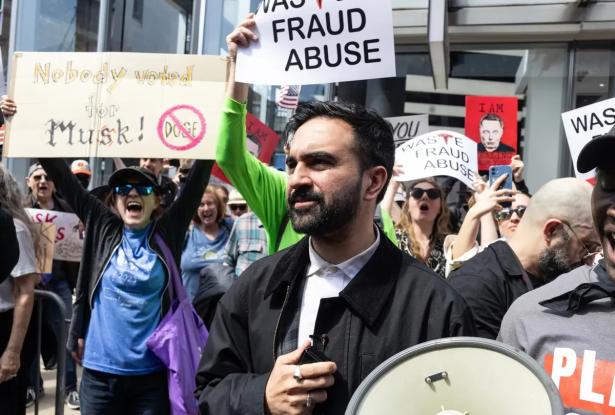If anyone needed a compelling argument for why New York City is in desperate need of socialist governance, the city’s real estate elites and the political class they own gave one last week. The Rent Guidelines Board, whose members are appointed by the mayor, voted on April 30 to consider drastic rent increases on at least one million rent-stabilized apartments. The nonbinding vote showed the board’s openness to raising rents by as much as 7.75 percent — in the midst of ever-skyrocketing rents that have pushed out enormous numbers of working-class people from the city in recent years.
Socialist mayoral candidate Zohran Mamdani has been campaigning on a promise to immediately freeze the rent for those very tenants. Of all the enticing campaign promises socialists make during an election season, this is one of the easiest to implement, since the mayor appoints the rent board and can pick members who will implement his agenda. Just as Mayor Eric Adams has consistently chosen members who side with landlords, Mayor Mamdani could appoint a pro-tenant board that would freeze the rent (as Mayor Bill de Blasio did).
It is an insult to the city’s working people that our real estate elites feel entitled, in the middle of a crippling affordability crisis, to further squeeze a million tenants living in rent-stabilized buildings. And it is part of the reason why Mamdani’s campaign has so much momentum.
As in many other US cities, housing costs cause New Yorkers immense hardship. Last month, the New York Times reported that not including migrants, about a third of families living in the city’s homeless shelters had at least one adult who was working. These are New York City’s workers: janitors, line cooks, construction workers, ambulance drivers, even librarians and nurses. They’re not in the shelters because of drug abuse or mental illness or failure to keep a job — they’re there because the rent is too damn high.
Homelessness complicates all of New York City’s public goods, spaces, and services. One in eight public school children are homeless, for example, requiring enormous additional support from a system already stretched thin. Homelessness is obviously a humanitarian and moral issue, but it is also impossible for the city to function well when so many people have nowhere to live. While many of the most visible homeless people need more than housing, thousands of working-class people now living in shelters simply need rent that is reasonably scaled to their take-home pay.
Those who are not flooding the shelters are leaving New York City, a grave loss for a city which has historically allowed people from all over the world to follow their dreams. A Citizens Budget Commission report last year found that the city lost 160,000 residents, an exodus in which housing costs were a huge factor. Rent stabilization is key to keeping many New Yorkers in their homes, but the power of landlord money means that this basic protection is constantly imperiled.
Mamdani’s proposed way forward includes both freezing the rent on rent-stabilized units and using city dollars to build 200,000 new affordable homes. Using the public sector to house people is something that New York City has a rich history of doing well, and it’s much needed: waiting for private set-asides on the luxury housing stock is never going to address the gap between New Yorkers’ housing needs and the available supply (the Regional Plan Association has estimated that the city needs nearly half a million new units by 2032).
Mamdani speaking during a press conference on universal childcare at Columbus Park Playground on November 19, 2024. (Michael M. Santiago / Getty Images)
Housing isn’t the only expense that New Yorkers are struggling with. More than half of New York families, both low- and high-income households, struggle to afford childcare costs, another expense driving many to leave the city. Childcare for just one child consumes about a quarter of a New York City family’s annual income, according to a recent New York City Council report.
Mayor Adams has consistently refused to make affordable childcare a priority, even cutting some programs. He has closed childcare centers in Brooklyn and Queens and slashed $112 million from the 3K program. On Monday, the Adams administration announced that it would no longer enroll families in a popular childcare voucher program because of funding uncertainties in the state budget. Mamdani has run on a promise of universal childcare for New Yorkers, by improving wages for childcare workers, expanding current 3K programs and funding new programs.
He’s also tackling a problem most politicians avoid: the cost of groceries, through municipal grocery stores — a public option for food. The idea is popular among New Yorkers, with two-thirds of voters supporting it in a recent Data for Progress poll. And we aren’t alone: Chicago is also considering the idea, and the Bulgarian government created a network of food stores with limited markup earlier this year. While the idea hasn’t succeeded everywhere it’s been tried, a small town in Kansas has been making it work for nearly two decades.
Mamdani is also proposing to raise the minimum wage to $30 an hour by 2030, starting at $20 in 2027. After 2030, under Mamdani’s proposal, the floor will continue to rise every year. The campaign cites data from Massachusetts Institute of Technology’s Living Wage Calculator, showing that this represents a living wage for a single adult in New York City.
Andrew Cuomo is still far ahead of Mamdani in the polls, but Mamdani is making far more of an impact in this race and on New York City politics as a whole than anyone expected. On Sunday, some two thousand people attended a Mamdani rally in Williamsburg, an exceptionally rare show of enthusiasm for any local political candidate. The slogan? “A City We Can Afford.”
Liza Featherstone is a columnist for Jacobin, a freelance journalist, and the author of Selling Women Short: The Landmark Battle for Workers’ Rights at Wal-Mart.



Spread the word